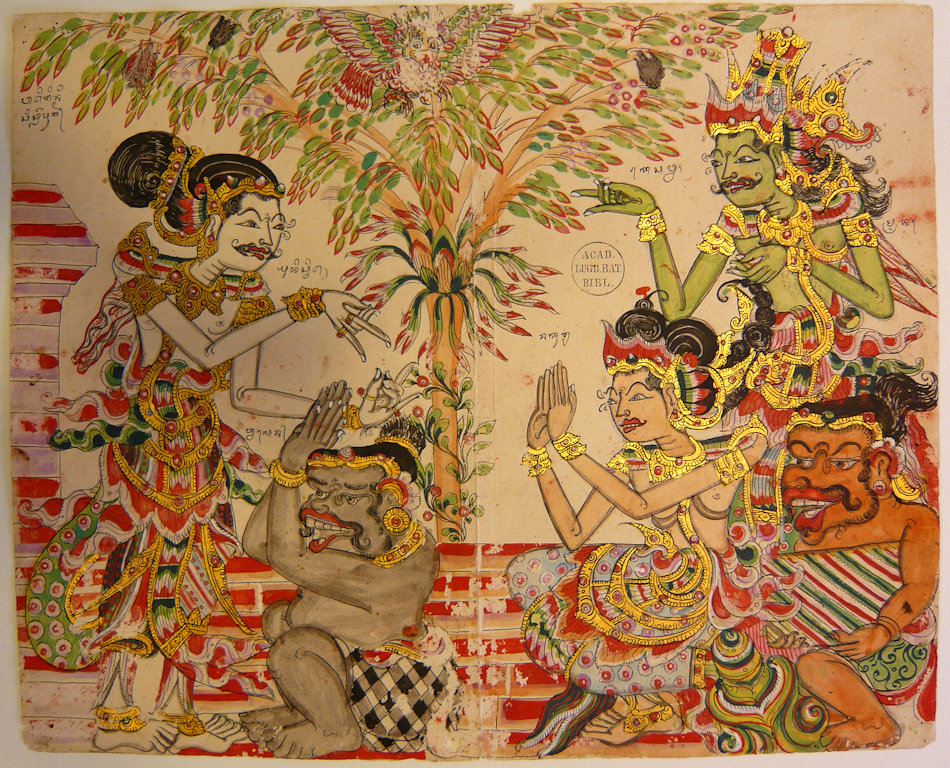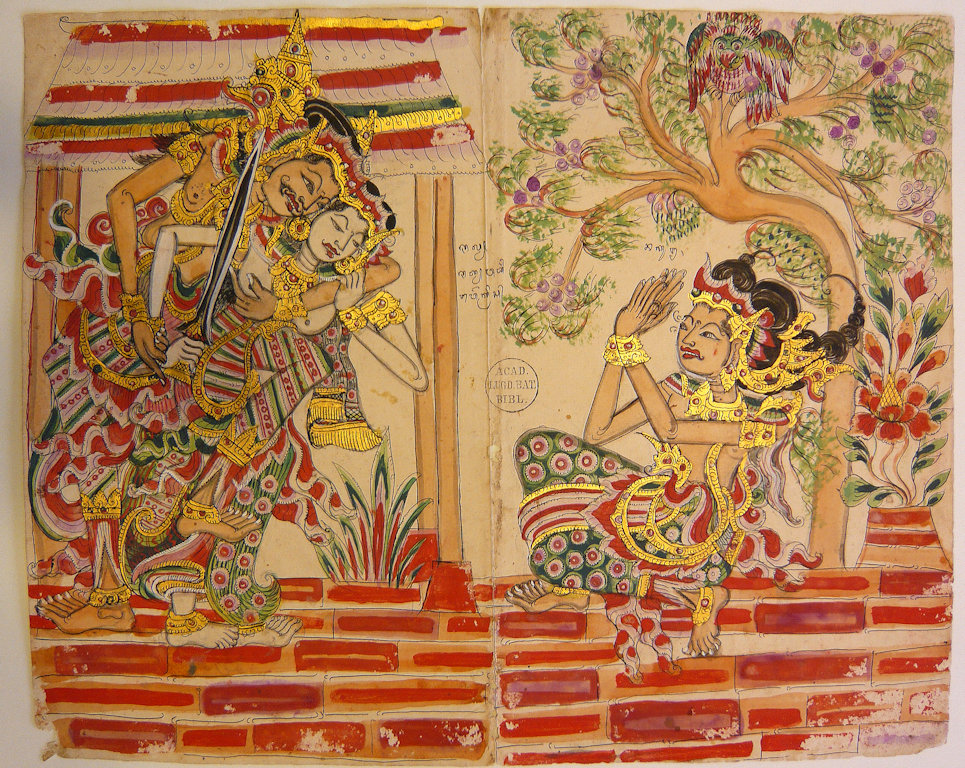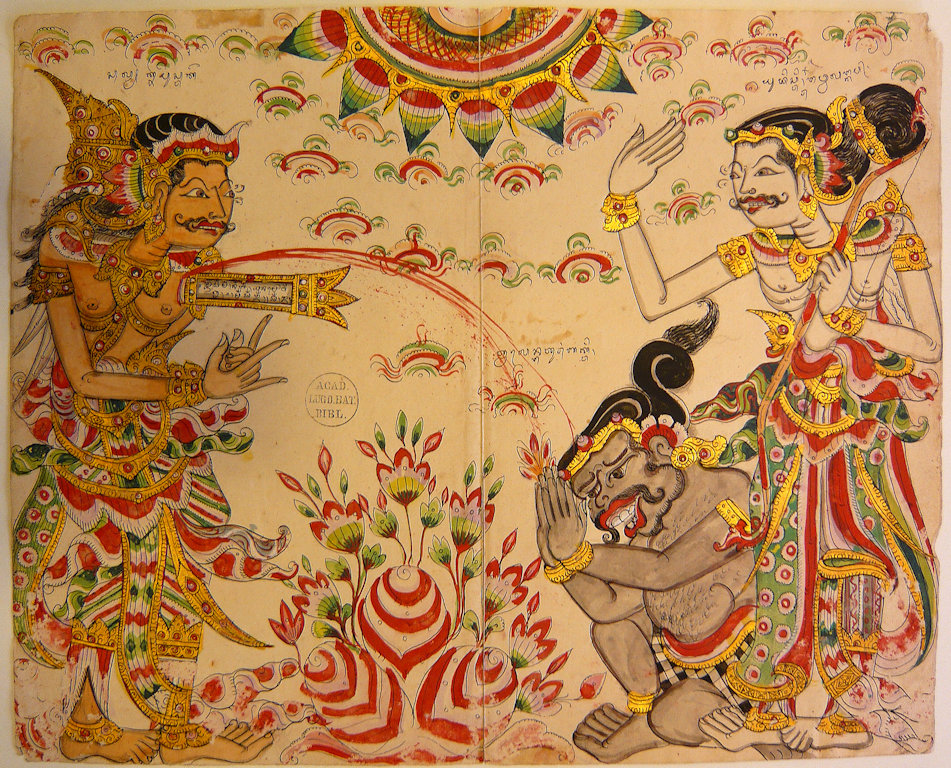KETOET GEDE, SINGARAJA, STORY FROM THE BHARATAYUDDHA, THE DEATH OF SALYA
LOr. 3390-307
Drawing on Dutch paper, watermark Pro Patria, countermark VdL., 34 x 42 cm
Yudistira (left) and Kresna (right) are standing and discussing something. Nakula, bottom right, and in front of him the servant Twalèn kneel and honour Yudistira with a sembah. Mredah, holding a bag made of basketry for sirih utensils, watches on the right. There is a tree between the two groups of men with a bird in it. A text in Balinese script in the centre says: “waringin misi clepuk;;, a waringin tree with an owl. Such a bird is a bad omen. Close to the standing man on the left is written: “yudistira”, and to the figure kneeling at his feet: “twalèn’. At the top on the right is written: “késawwa”. Késawa is an epithet for Kresna. He is an incarnation of the god Wisnu. In the Bharatayuddha he is an ally of the Pandawa. On the far right in the centre is written: “mredah”, the second servant of the Pandawa party, and close to the man kneeling in front of him: “nakule”, Nakula.
This scene refers to an episode described in the Old Javanese Bharatayuddha (XXXVI: 1-2).The Pandawa have heard that Salya is to be appointed commander-in-chief of the Korawa party. They want to know whether this is true and they discuss how to defeat him. It is Kresna’s idea to have Nakula sent to Salya in order to find out what is going to happen. Nakula is chosen, because he is very close to Salya.

LOr. 3390-303
Drawing on Dutch paper, watermark Pro Patria, countermark VdL., 33.9 x 42.3 cm
Nakula kneels in front of Salya. Salya restrains his wife from stabbing herself to death and embraces her. A text in Balinese script in ink in the centre says: salya satyawati ngawe kris, Salya, Satyawati holds a kris. On the right is written; Nakule.
This scene refers to various episodes described in the Old Javanese Bharatayuddha. Salya thinks, although he has become commander-in-chief of the Korawa party, very highly of the Pandawa, particularly of Nakula, since he loves him very much (XXXVI: 4). In XXXVI: 9018, Salya, just home from his inauguration, is visited by Nakula. He kneels down in front of Salya. He refuses to fight Salya in the war and he asks Salya to kill him beforehand with a weapon. Salya refuses to do so. He says that he will fight Yudistira later on and that he will be killed by his book-arrow. Nakula finally leaves. In XXXVII: 11, Satyawati tells her husband that she wants to kill herself then. She does not want to see her husband dead, killed in the battle. She takes a kris and points it at her breasts (XXXVIII: 1).

LOr. 3390-304
Drawing on Dutch paper, watermark Pro Patria, countermark VdL., 33.9 x 42.1 cm.
Salya is hit by Yudistira’s book arrow. Yudistira holds a bow. His servant Twalen pays homage to Salya. A text in Balinese script in ink at the top left says: salya kna pustake, Salya hit by the book-arrow. On the book-arrow is written: om am mam, nam bam,ya namo wigna, man am om, am 3. These words are holy syllables and formulas in Sanskrit which are uttered three times. At the top on the right is written: yudistira, ngawwa langkap, Yudistira holds a bow. In the centre: twalen ngaturang bakti, Twalen pays homage.
This scene refers to an episode described in the Old Javanese Bharatayuddha XL: 1-10. Salya has dressed himself in his best clothes and prepares for battle. The Korawa are on the losing side. Salya takes his rudrarosa arrow, which is of extraordinary power. The gods decide that nobody except Yudistira shall fight Salya usring this arrow. In XLI ,Kresna orders Yudistira to fight. He goes reluctantly. In XLII: 5, Kresna orders him to use the book-arrow, In XLII: 8 Salya is hit by the arrow. Thunder, darkness while the sun is still shining and rain accompany his death. These signs indicate that a great man goes to heaven.

